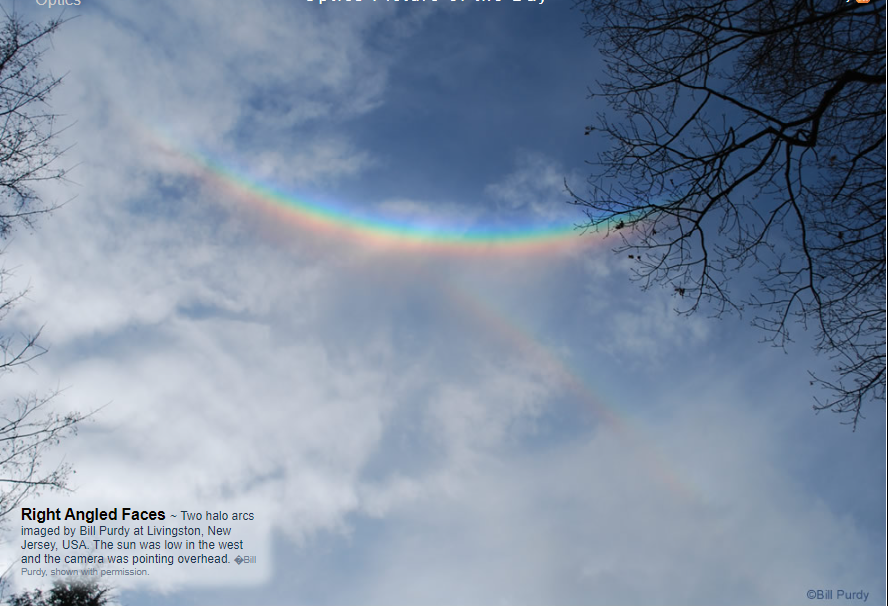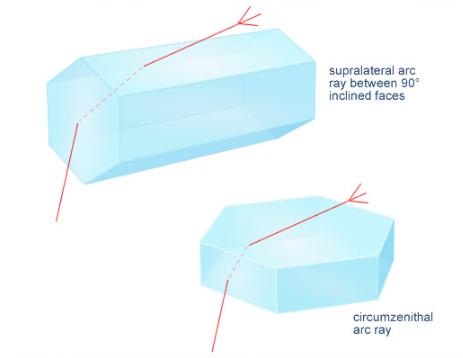Right angles
Exploring the Fascinating Phenomenon of Right Angled Faces in Atmospheric Optics
Atmospheric optics never ceases to amaze with its intricate displays of light and color. Among the many captivating phenomena, one that stands out is the presence of right angled faces, which give rise to unique halo arcs in the sky. In this article, we will delve into the mesmerizing world of right angled faces and the halo arcs they create, shedding light on their formation, characteristics, and significance.
The Enigmatic Circumzenithal Arc and its Companion
A familiar sight to avid skywatchers, the circumzenithal arc is often referred to as a "smile in the sky." This ethereal arc can be observed overhead about once a month when the sun hangs low. But here's where it gets intriguing: whenever you catch a glimpse of this elusive halo, be sure to look for its fainter companion, which curves downwards. This is the supralateral arc, sometimes mistaken for the rarely seen 46° halo.
Hexagonal Crystals and Right Angles
The formation of these captivating halo arcs can be attributed to the interaction of sunlight with ice crystals in the atmosphere. The circumzenithal arc arises from hexagonal plate-shaped ice crystals drifting with their large faces horizontal. On the other hand, the supralateral arc originates from hexagonal columns drifting with their long axes horizontal. What's intriguing is that both these crystal formations have one thing in common: they involve sun rays refracted between crystal faces at right angles to one another.
A Kaleidoscope of Colors
One of the most striking aspects of these halo arcs is their vivid and widely separated colors. This color separation occurs due to the effective passage of rays through a 90° prism formed by the ice crystals. In contrast, other halos such as the common 22° halos and sundogs, which are formed by 60° prism rays, exhibit less color separation. To truly appreciate the difference, compare the color widths between a fragment of a supralateral arc and a 22° halo in an image captured by Bill Purdy.
Unlocking the Secrets of Right Angled Faces
As we unravel the secrets behind right angled faces and their impact on atmospheric optics, it becomes clear that these phenomena hold valuable insights for researchers and enthusiasts alike. By studying the intricate details of halo arcs formed by these unique crystal configurations, scientists can gain a deeper understanding of the properties and behavior of ice crystals in the atmosphere. This knowledge, in turn, contributes to our understanding of meteorology, climate patterns, and even the formation of clouds.
Captivating the Imagination
Beyond their scientific significance, right angled faces and their resulting halo arcs have an undeniable aesthetic appeal. These celestial displays capture the imagination and evoke a sense of wonder and awe. Whether it's the smile-like curvature of the circumzenithal arc or the graceful downward curve of the supralateral arc, these ethereal phenomena remind us of the beauty and complexity of the natural world.
A Call to Observe and Appreciate
As we conclude our exploration of right angled faces in atmospheric optics, we encourage you to keep your eyes to the sky and be on the lookout for these captivating halo arcs. The next time you witness a circumzenithal arc, take a moment to search for its faint companion, the supralateral arc. Observe the vibrant colors and appreciate the intricate interplay between light and ice crystals. By embracing the wonders of atmospheric optics, we open ourselves up to a world of enchantment that constantly beckons us to gaze upwards in awe.

Right Angled Faces ~ Two halo arcs imaged by Bill Purdy at Livingston, New Jersey, USA. The sun was low in the west and the camera was pointing overhead. �Bill Purdy, shown with permission.

The brighter arc is the more familiar. It is a circumzenithal arc or �smile in the sky� seen overhead maybe once a month on average when the sun is low . Whenever it is glimpsed (it is a will-o�-the-wisp halo) look for a fainter downwards curving companion. That is the grandly named supralateral arc, too often mistaken for the hardly ever seen 46� halo.
The circumzenithal arc is made by hexagonal plate shaped ice crystals drifting with their large faces horizontal. The supralateral comes from hexagonal columns drifting with their long axes horizontal.
What they have in common is that they are both formed by sun rays refracted between crystal faces at right angles to one another. And their colours are bright and widely separated.
The colour separation results from the effective ray passage through a 90� prism. Everyday 22� halos and sundogs formed by 60� prism rays have less separated colours. Bill�s lower image shows a fragment of a supralateral arc (right) and 22� halo (left) � compare the colour widths.

Note: this article has been automatically converted from the old site and may not appear as intended. You can find the original article here.
Reference Atmospheric Optics
If you use any of the definitions, information, or data presented on Atmospheric Optics, please copy the link or reference below to properly credit us as the reference source. Thank you!
-
<a href="https://atoptics.co.uk/blog/right-angles/">Right angles</a>
-
"Right angles". Atmospheric Optics. Accessed on November 25, 2024. https://atoptics.co.uk/blog/right-angles/.
-
"Right angles". Atmospheric Optics, https://atoptics.co.uk/blog/right-angles/. Accessed 25 November, 2024
-
Right angles. Atmospheric Optics. Retrieved from https://atoptics.co.uk/blog/right-angles/.